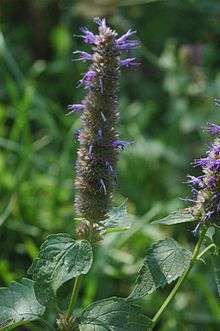Agastache rugosa
| Korean mint | |
|---|---|
 | |
| Scientific classification | |
| Kingdom: | Plantae |
| (unranked): | Angiosperms |
| (unranked): | Eudicots |
| (unranked): | Asterids |
| Order: | Lamiales |
| Family: | Lamiaceae |
| Genus: | Agastache |
| Species: | A. rugosa |
| Binomial name | |
| Agastache rugosa (Fisch. & C.A.Mey.) Kuntze[1] | |
| Synonyms[2] | |
| |
Agastache rugosa (Korean mint, blue licorice, purple giant hyssop, huo xiang, Indian mint, wrinkled giant hyssop; syn. Lophanthus rugosus Fisch. & C.A.Mey.) is a medicinal and ornamental plant in the Lamiaceae family.
Traditional uses
In Korea, it is called (방아잎, bangannip), and used for Korean pancake and stew, more specifically for Bosintang and Chu-eo-tang. Chu-eo-tang is a soup or stew cooked with Chinese muddy loach. It is called (Chinese: 藿香; pinyin: huò xiāng)[3] in Chinese and it is one of the 50 fundamental herbs used in traditional Chinese medicine.[4]
Chemicals isolated from Agastache rugosa have some antibacterial properties.[5] The extracts have shown antifungal activity in in vitro experiments.[6] Agastache rugosa may have anti-atherogenic properties.[7]
Chemical constituents
Chemical compounds found in the plant include:[8]
- Estragole, plant
- p-Anisaldehyde, plant
- 4-methoxycinnamaldehyde,[9] shoot
- Pachypodol, leaf
- Methylchavicol (60.01-88.43%),
- d-Limonene
- Caryophyllene
- Hexadecanoic acid
- Linoleic acid
- Octahydro-7-methyl-methylene-4-(1-methylethyl)-1H-cyclopenta [1,3] cyclopropa[1,2]benzene[10]
See also
References
- ↑ "Agastache rugosa information from NPGS/GRIN". USDA. Retrieved 2008-02-19.
- ↑ "The Plant List: A Working List of All Plant Species". Retrieved 19 April 2015.
- ↑ "Agastache rugosa". Flora of China. Missouri Botanical Garden. Retrieved 2008-02-19 – via eFloras.org.
- ↑ "Agastache rugosa - Plants For A Future database report". Archived from the original on 3 March 2008. Retrieved 2008-02-14.
- ↑ Production of antibacterial substance against bovine pneumoniae bacteria from Agastache rugosa Jang B.-G., Lee D.-H., Lee J.-S. Korean Journal of Microbiology and Biotechnology 2005 33:2 (142-147)
- ↑ Antifungal effect of extracts of 32 traditional Chinese herbs against intestinal Candida in vitro Deng J.-H., Wang G.-S., Ma Y.-H., Shi M., Li B. World Chinese Journal of Digestology 2010 18:7 (741-743)
- ↑ Inhibition of cytokine-induced vascular cell adhesion molecule-1 expression; possible mechanism for anti-atherogenic effect of Agastache rugosa Hong J.-J., Choi J.-H., Oh S.-R., Lee H.-K., Park J.-H., Lee K.-Y., Kim J.-J., Jeong T.-S., Oh G.T. FEBS Letters 2001 495:3 (142-147)
- ↑ "Species Information". Dr. Duke's Phytochemical and Ethnobotanical Databases. Retrieved 2008-02-19.
- ↑ 4-Methoxycinnamaldehyde inhibited human respiratory syncytial virus in a human larynx carcinoma cell line Wang K.C., Chang J.S., Chiang L.C., Lin C.C. Phytomedicine 2009 16:9 (882-886)
- ↑ Chemical composition of essential oil in stems, leaves and flowers of Agastache rugosa Yang D., Wang F., Su J., Zeng L. Zhong yao cai = Zhongyaocai = Journal of Chinese medicinal materials 2000 23:3 (149-151)
External links
- Agastache rugosa photo
- Plants For A Future: Agastache rugosa
- Agastache rugosa Medicinal Plant Images Database (School of Chinese Medicine, Hong Kong Baptist University) (traditional Chinese) (English)